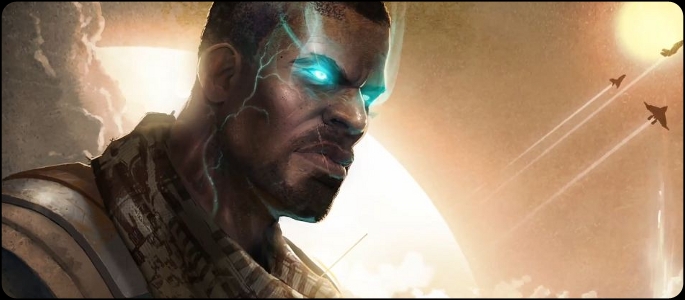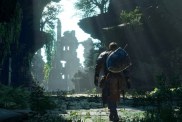
Lightbox Interactive approached Starhawk with the goal of differentiating it from the various other shooters currently saturating the market. After experiencing some hands-on time with the action packed title, it would be a vast understatement to say they succeeded.
First, some background. The game takes place in space, where you, as rifter Emmit Graves, set out with your brother to mine rift energy on various planets throughout the universe. What’s rift energy? Think of it as that super valuable stuff from Avatar, only instead of a type of rock, it’s a plasma-like substance that glows. Or something like that. Anyway, Emmit and his brother are exposed to rift energy and subsequently become mutants. However, Emmit is saved Ironman-style and dedicates his life to defending other rifters from mutants, including his brother.
What makes Starhwak stand out from the rest –including it’s spiritual predecessor– is the introduction of the Build and Battle system where players have the ability to build structures to aid them in their fight against the enemy, which adds a sort of RTS style of game play both online and off. To give you an idea of how it all works, we’ll walk you through our multiplayer demo of capture the flag.
The multiplayer demo of capture the flag took place on a large, brown, uneven landscape of a distant planet. After what could only be described as space pods rained down on the battle field and opened to reveal their passengers, the two teams rushed to each other’s home bases (where, presumably, the flags were held). I kind of just stood there and watched as players from both teams battled it out against one another around me. When one person would die and fall to the ground, orbs of rift energy would appear where their lifeless body laid seconds before. The victor then absorbed the energy and continued fighting. I saw this happen many times over the course of a few minutes while getting familiar with the controls and, after getting zero attention from anyone else, began to believe I was invisible on the field. Then a vehicle ran me over. I respawned, and from that point on, I was determined to get in on the action.
Running around on the ground and shooting other players felt very similar to Warhawk. If I didn’t know any better, I’d say it was the same game, only more refined. The mechanics are tighter and the weapon physics work well in the sense that you have more control over where you want your gun to shoot. It’s obvious that Lightbox took what worked in Warhawk and used it as a foundation to build and improve upon.
Once I had acquired enough rift energy, I built an automatic turret near the enemy base and proceeded to rack up kills from afar. This proved to be quite the inconvenience for them. My personal victory was short-lived, however, when the enemy built a few walls to hide behind before turning my turret into space dust. It was interesting to witness the opposite team think it’s way out of a problem and apply a working solution in real-time. I not only felt defeated, but I was also excited to see how such a relatively small addition to a great game made such a huge difference in how it’s played. As for what we might expect in the final product, we’re able to spend time with Lars Devore, Starhawk’s creative director, who told us that, among others, lobbies, parties, and a clan system are features to definitely look forward to.
Between automatic turrets, sniper towers, walls, garages for building vehicles, and even hawk pads, players have a wide selection of ways in which they can manipulate the playing field, forcing the opposing team to rethink it’s strategy on the fly. It’s this type of fast paced, strategic online gameplay that Lightbox seems to love and hopes you will, too. I certainly did.
Single Player
The single player demo showed off Starhawk’s unique story telling mechanics, where cut scenes dissolve seamlessly from in-game action. The gameplay was linear in the sense that the Emmit had to build structures to complete certain objectives as they arose. In this case, the objective was to defend a rift energy structure from mutants. I built turrets, lit some dudes up, and was having a pretty swell time. The I had to erect a hawkpad, providing me with an excuse to take the battle into the air. Again, the flight controls are very similar to Warhawk, so veterans of the series should be more than comfortable. From gameplay to story, the single player campaign showed huge potential in being able to carry its own against its online counterpart.
Admittedly, I feel as if being a fan of Warhawk allowed me to be easily captivated by this game. A little biased, I know, but I certainly don’t feel as though that personal bias had any effect on my impression of Starhawk. It would be a huge mistake to say the two titles aren’t alike –they are–, but the differences are significant enough to warrant serious consideration from those who passed on the series in the past. Also, it’s worth nothing that this demo certainly felt and played like a finished product despite being derived from a pre-alpha stage build. With many more months until the title is finalized, it will be exciting to see how Lightbox fine-tunes what already is shaping up to be an excellent game.
Starhawk is slated to land on store shelves sometime in the Spring of 2012.








